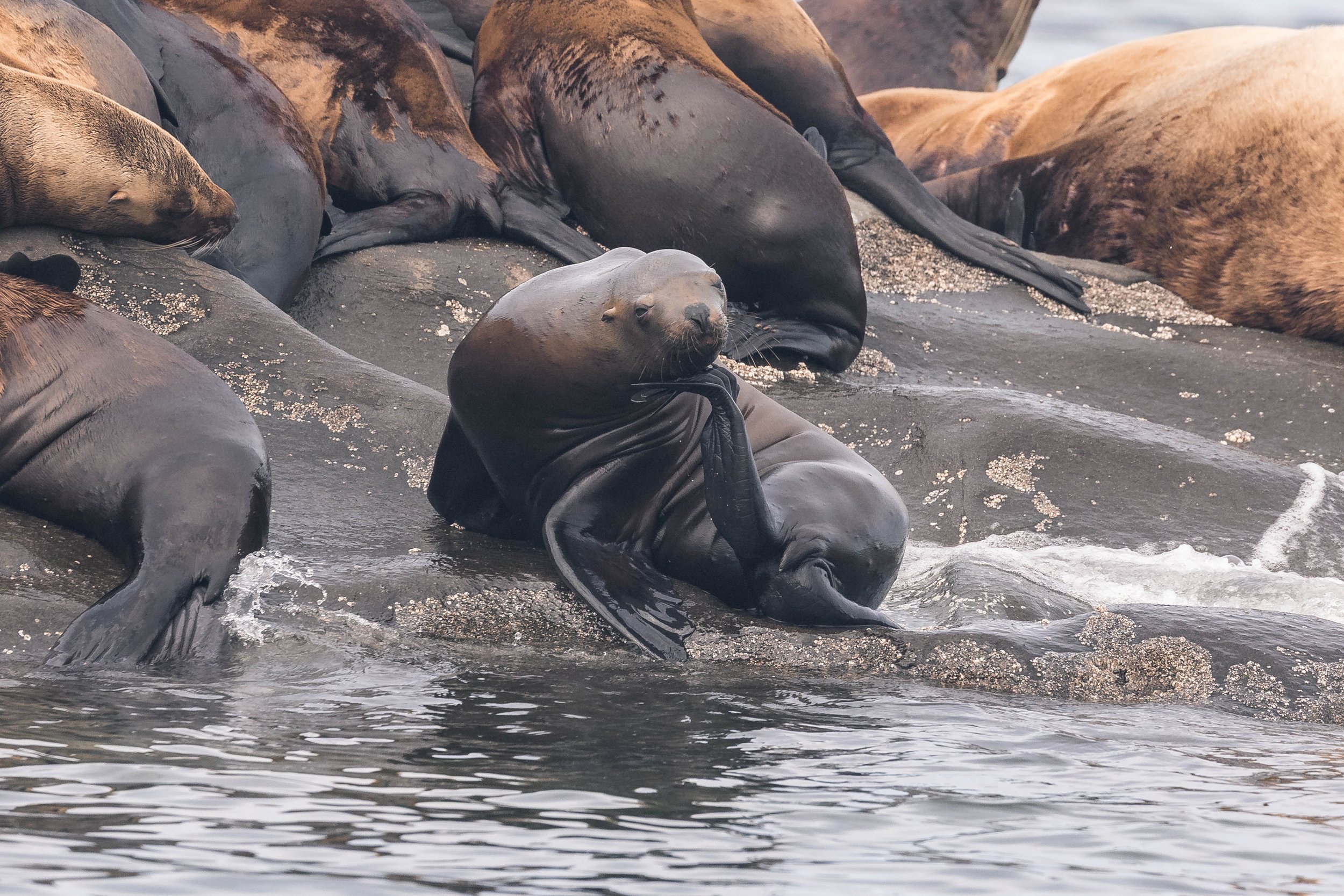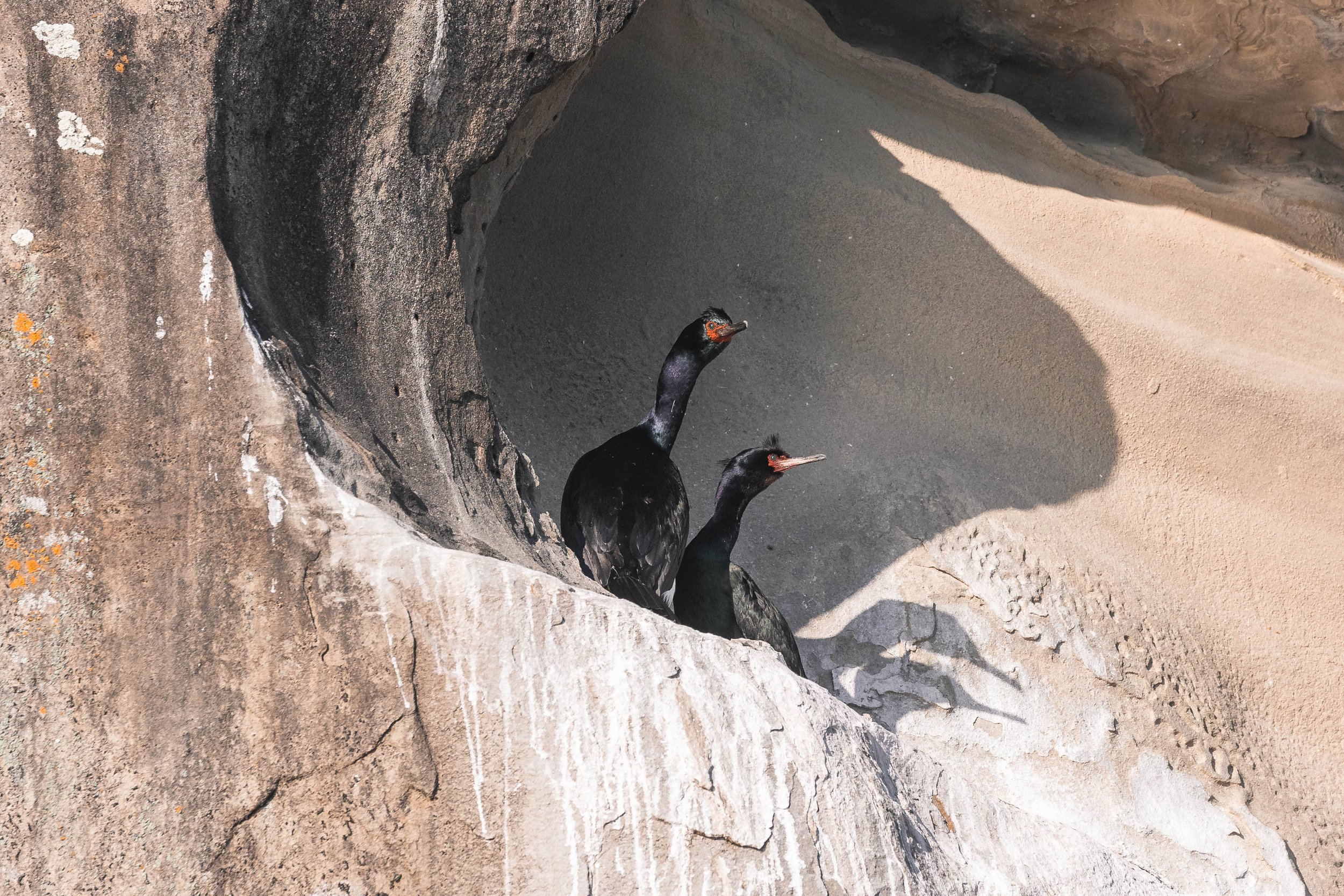June 4, 2025, 3:30 PM - Humpbacks and Sea Lions and Eagles, OH MY
It was a wonderful day for whale watching, with the clouds clearing and the sun shining as we left, but before we could even leave the dock, we spotted our first wildlife. It was a Great Blue Heron! These large birds are some of the biggest that we have in BC, with the same 6.6-foot wingspan as the bald eagle. Since this one is a common visitor to our docks, we have given him a nickname, Henry!
After admiring Henry for a while, we were able to push off the dock. We headed south from Nanaimo, searching first through the Southern Gulf Islands. Heading through Dodd Narrows is always a favourite, since the currents that get running there can be so fun! From here, we searched through the islands until Gabriola Pass, where we headed out into the more open waters of the Strait of Georgia. Before getting too far, we made a stop at Stinky Rock to see some of our Pinniped friends. It was the Steller Sea Lions that we found hauled out on the rocky shoreline, with their large numbers and large bodies. These impressive animals can reach weights of 2,800 pounds! It’s just the males that get to be this big, though. The females will max out close to 800 pounds, which is still quite impressive. These Sea Lions are also quite funny to watch, as they’re always fighting with each other for positioning on the rocks.
After our time here, we continued out into the open water to continue our search for whales. And boy, did we have luck! It seems like the humpbacks have returned in full force, since as we cruised through the Strait, we saw multiple blows in the distance! As we went along, we ended up seeing two pairs of humpbacks, with two singles spotted afterwards. That is a total of 6 humpbacks spotted this tour!
The first pair we encountered was Kata (BCY1218) and Apollo (BCY0172), spending time together. This was a striking pair, as they both have a large portion of white on their tails. There is some regional variance in the colour of the whales, with the northern hemisphere humpbacks tending to be darker than the population in the southern hemisphere. It’s not fully understood why this is the case. It might just be pure coincidence due to genetic isolation from each other, or there may be some benefit to the lighter colouration in the south. Hopefully, more research will reveal these answers for us! For now, we are just happy to witness the variation amongst our local whales.
The next pair that we saw was Kelpie (BCY1276) and Lorax (BCX1602). These two seemed to be feeding in the area at first, until their behaviour changed and they seemed to get a bit more playful. This playfulness was directed towards a stick at first! It’s not unheard of to see humpback whales playing with sticks while we are on the water, although it’s always entertaining! People didn’t always think that humpback whales were the most interesting to watch, but the more time you spend with them, the more you realize just how wrong that is. Each whale has their unique personality and you learn to recognize them not only for their looks, but also their different behaviours. It is fascinating. One of the interesting things that scientists are looking further into is what drives these associations between whales.
The next two whales that we spotted were travelling solo. Although seeing the whales in pairs or larger groups is becoming more common as time progresses, it wasn’t too long ago that travelling solo was the norm for the humpbacks. As their populations increase, this is changing, but humpbacks are still very capable of solo life. And just because we see one travelling alone today doesn’t mean they might not meet up with others later, or vice versa.
The first solo whale we were able to ID as Lure (BCY1248). We didn’t stay long with Lure, just long enough for a nice tail swish at the surface and a great look at their dorsal fin before they slipped back below the surface. We ended up moving on and finding out next humpback: Fallen Knight (BCX0915). Fallen Knight is a very cool whale to look at, not because of her colouration, but rather her unique tail shape. She has a very noticeable curl on the right side of her tail, making her easy to ID even though she doesn’t have much in the way of scarring. Fallen Knight is a known female, having brought back 3 calves: Portrait (2019), Camelot (2021) and one last year in 2024! We love seeing the ladies out there since they are so important for the recovery of this amazing species. Calves will return to the same feeding and breeding areas that their mothers do, so we will likely see more of these young whales as time goes on. We saw Camelot the day before for our first time, so it was even more exciting to see Fallen Knight today!
After the whales, we had a final stop at the Gabriola Bluffs, getting to see the various seabirds that are nesting along the cliffs. Our favourite was probably the Bald Eagles since we got a great look at the two Bald Eagles that were peeking over the side of the nest! It was a great way to end this amazing trip. Our onboard Marine Naturalist Hayleigh Hilbert captured some great photos of all these wildlife encounters, which can be viewed below!
Henry the Great Blue Heron spending time near our boats.
Henry sunning himself.
Harbour Seals hauled out on the rocks near Stinky Rock.
A Steller Sea Lion scratching their chin.
A big Male Steller Sea Lion at Stinky Rock.
Another Male further down the rocks.
Apollo arching her back for a dive.
Apollo making a fluke waterfall as she lifts her tail to dive.
The beautiful white underside of Apollo’s tail flukes.
A great look at Kata’s dorsal fin with the big notch out of the top.
Kata lifting their tail to dive.
Kata lifting their tail to dive with Apollo just behind them.
The underside of Apollo’s tail as she dove.
A lovely fluke waterfall from Kata.
The unique underside of Kata’s tail flukes.
Kelpie’s scarred up dorsal surface.
Kelpie going for a dive.
The underside of Lorax’s tail.
The speckled underside of Kelpie’s tail.
Lorax playing with a stick.
Lorax with their rostrum out of the water.
Kelpie’s right dorsal fin.
Lorax lifting their tail in the air.
Kelpie diving behind Lorax.
Lorax lifting her rostrum.
Not by the hairs on Lorax’s chinny chin chin.
Lorax moving the water around as she surfaces.
Lure’s dorsal fin.
Lure Flicking their tail at the surface.
Fallen Knight going for a dive.
A very photogenic gull at the Gabriola Bluffs.
Cormorants nesting on the Bluffs.
One of the Bald Eagles watching from the top of their nest tree.
One of the Bald Eagle Eagle babies watching from the nest.


































